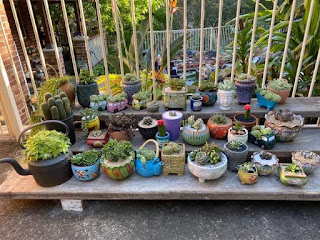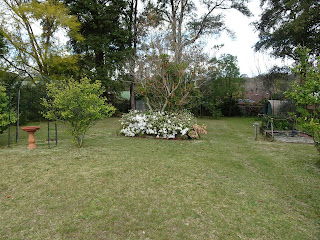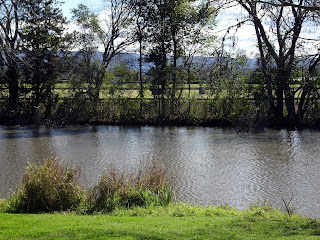Adventure on The Ghan - 5 March, 2014 Day 1 (Throwback Memory)
What better way to see the rich, red earth of outback Australia than to travel in the luxurious comfort of an air-conditioned train on its journey from Darwin to Adelaide, right down the centre of Australia! The Ghan train was named for the pioneering cameleers from Afghanistan who blazed a permanent trail into the Red Centre of Australia more than 150 years ago.
Ken and I did this epic journey six years ago. We boarded the Ghan train in Darwin and arrived three days later in Adelaide. During that time we enjoyed gourmet dining with local wines and also off-train excursions to Katherine Gorge and Alice Springs.
Our accommodation on the train consisted of a Twin Gold Service Compartment with our own en-suite bathroom, including toilet and shower.
During the day our beds converted to a long three-seater lounge where we could sit and admire the ever-changing scenery and, at night, a steward would come and convert our lounge into twin bunks.
On the first day, we departed our hotel in Darwin at 8.00 am and were picked up, with other passengers, by bus and driven to the station, on the outskirts of the town. The train was waiting for us and the bus drove along beside it, depositing passengers and luggage at their appointed carriage.
Our cabin was very comfortable and we soon made ourselves at home, unpacking a few clothes and hanging them up in the wardrobe.
Lunch that first day was in the on-board art deco themed Queen Adelaide Restaurant with the tables designed to seat two people either side with amazing views of the outback visible through the windows. We were seated opposite John and Joy, a couple from Victoria, also enjoying their first time trip on the Ghan. Our meal, prepared by on-board chefs, consisted of an entree of damper and pate, followed by Beef Medallions for Ken and a Goat's cheese tart for me with desserts of Panna Cotta and Lemon Meringue tart to follow. The food was delicious and nothing was too much trouble for the waiting staff.
After lunch, the train stopped at
Katherine. We were transported by air-conditioned bus to
Katherine Gorge for a boat cruise on the
Katherine River. We were in the local Indigenous
Jawoyn Country and they were our hosts on the river cruise. Their name for the Gorge is
Nitmiluk, meaning
Cicada Place. As we boarded the boat we were handed a plastic container holding fruit salad together with a bottle of soft drink to provide us with refreshments for the journey.
We cruised slowly down the Gorge between towering sandstone cliffs. There were boulders of sandstone perched on top of each other, like piles of giant marbles. Trees lined the banks, some growing up high amongst the boulders. I noted several Rock Wallaroos on the rock escarpments. There were also Goannas on the rocks and Buffalos swimming across the river. Fortunately, I did not see any Crocodiles. The scenery was breathtaking and I felt we were in a special and sacred place, steeped in the culture of the Aboriginal Dreamtime. We were not able to cruise the second Gorge because of the high level of the River. It was the wet season and the river had risen. Also the mythical Boolong, the Rainbow Serpent resides in the second Gorge where it is deeper and he must not be disturbed! His presence helps to bring on the rains but, if he is disturbed, he can prevent the rains coming and this will cause drought and people to perish.
We left the boat at the end of the first Gorge and had a little walk around on the sand and rocks, looking into the second Gorge, being careful not to disturb Boolong. We then re-boarded our boat for the return trip down the Gorge. It was very hot and I felt the sun beating down on me. The boat was crowded and we were unable to find seats in the shade and I was glad I had worn a hat!
After our cruise, we walked back to the buses to be transported back to the
Ghan. It was amazing to see our train just waiting there for us, in the desert. It seemed so out of place, but at the same time comforting to know that inside we would find all the modern-day comforts we needed to survive in the outback. We were hot and exhausted as we piled out of the bus, eager to get back to our cabin and cool off.
Ken and I were on the first sitting for dinner at 6.30 pm. We started off with soup, then luscious lamb cutlets with apple pie for dessert. We also had some local wine.
We enjoyed looking out at the deep red earth in the outback of the
Northern Territory in the
"Top End" of
Australia.
After dinner some passengers were settling down in the
lounge car, quite obviously intent on having a long boozy party night, but we decided this was not for us.
We stayed a little while in the
lounge and watched the sunset over the desert and then returned to our cabin.
Our beds were made up when we got back, so we decided to retire for the night. I had a shower in the little bathroom. This proved to be quite a challenge, in the lurching train as the shower water went flying around in the small space. It was difficult to find a place where my clothes would not get wet, but somehow I managed it, just grateful to have a lovely hot shower. Ken took the top bunk as I didn't fancy climbing the ladder! We were looking forward to the next day and our trip to
Alice Springs.
Our boat about to enter the
Gorge. Our
Aboriginal guide told us stories from the
Dreamtime of
Bula the Creator and
Nabilil, a dragon-like creature who camped at the entrance to the
Gorge.
Part of the spectacular scenery as we cruised through the
Gorge.
Katherine Gorge snakes its way for 12 km along the
Arnhem Land Plateau on its way to the sea. The cliffs can tower up to 70m high.




















































